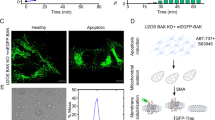Abstract
The oxidative phosphorylation inhibitor DBCT (dibutylchloromethyltin chloride) inhibits state 3 respiration at a concentration less than that which stimulates K+ flux into respiring rat liver mitochondria. Inhibition of ADP-stimulated respiration by DBCT can be reversed or blocked by the dithiol 2,3-dimercaptopropanol. The data are consistent with previous suggestions that DBCT may interact with the ATP synthase via reaction with a dithiol group. The stimulation of K+ influx by DBCT is partially reversed by concentrations of 2-mercaptoethanol which fail to affect the inhibition of state 3 respiration by DBCT. The combination of DBCT plus 2,3-dimercaptopropanol inhibits mitochondrial K+ influx. The inhibitory effect of dicyclohexylcarbodiimide on K+ influx is not expressed in the presence of DBCT. Atractyloside has little effect on K+ influx in the presence or absence of DBCT. The combination of DBCT plus uncoupler induces a net loss of endogenous K+. Consideration is given to the alternative hypotheses that the acceleration of K+ influx by DBCT may involve either a direct link to the energy transduction apparatus, or may occur via separate activation of a passive transport mechanism.
Similar content being viewed by others
References
Aldridge, W. N., Street, B. W., and Skilleter, D. N. (1977).Biochem. J. 168 353–364.
Azzone, G. F., Bortolotto, F., and Zanotti, A. (1978).FEBS Lett. 96 135–140.
Bogucka, K., and Wojtczak, L. (1979).FEBS Lett. 100 301–304.
Brierley, G. P., Jurkowitz, M., and Jung, D. W. (1978).Arch. Biochem. Biophys. 190 181–192.
Bygrave, F. L., Ramachandran, C., and Robertson, R. N. (1978).Arch. Biochem. Biophys. 188 301–307.
Cain, K., and Griffiths, D. E. (1977).Biochem. J. 162 575–580.
Cain, K., Partis, M. D., and Griffiths, D. E. (1977).Biochem. J. 166 593–602.
Chavez, E., Jung, D. W., and Brierley, G. P. (1977).Arch. Biochem. Biophys. 183 460–470.
Dawson, A. P., Farrow, B. G., and Selwyn, M. J. (1982).Biochem. J. 202 163–169.
Diwan, J. J. (1981).Biochem. Soc. Trans. 9 153–154.
Diwan, J. J. (1982).J. Bioenerg. Biomembr. 14 15–22.
Diwan, J. J., Daze, M., Richardson, R., and Aronson, D. (1979).Biochemistry 18 2590–2595.
Diwan, J. J., and Lehrer, P. H. (1978).Membr. Biochem. 1 43–60.
Diwan, J. J., Markoff, M., and Lehrer, P. H. (1977).Indian J. Biochem. Biophys. 14 342–346.
Diwan, J. J., and Tedeschi, H. (1975).FEBS Lett. 60 176–179.
Dordick, R. S., Brierley, G. P., and Garlid, K. D. (1980).J. Biol. Chem. 255 10299–10305.
Duee, E., and Vignais, P. V. (1969).J. Biol. Chem. 244 3920–3931.
Fluharty, A. L., and Sanadi, D. R. (1961).J. Biol. Chem. 236 2772–2777.
Garlid, K. D. (1980).J. Biol. Chem. 255 11273–11279.
Gauthier, L. M., and Diwan, J. J. (1979).Biochem. Biophys. Res. Commun. 87 1072–1079.
Harris, E. J. (1978).Biochem. J. 176 983–991.
Harris, E. J., and VanDam, K. (1968).Biochem. J. 106 759–766.
Johnson, J. H., and Pressman, B. C. (1969).Arch. Biochem. Biophys. 132 139–145.
Joshi, S., and Hughes, J. B. (1981).J. Biol. Chem. 256 11112–11116.
Joshi, S., Hughes, J. B., Shaikh, F., and Sanadi, D. R. (1979).J. Biol. Chem. 254 10145–10152.
Joshi, S., and Sanadi, D. R. (1979).Methods Enzymol. 55 384–391.
Jung, D. W., Chavez, E., and Brierley, G. P. (1977).Arch. Biochem. Biophys. 183 452–459.
Jung, D. W., Shi, G.-Y., and Brierley, G. P. (1980).J. Biol. Chem. 255 408–412.
Jung, D. W., Shi, G.-Y., and Brierley, G. P. (1981).Arch. Biochem. Biophys. 209 356–361.
Kiehl, R., and Hatefi, Y. (1980).Biochemistry 19 541–548.
LaNoue, K., Mizani, S. M., and Klingenberg, M. (1978).J. Biol. Chem. 253 191–198.
Layne, E. (1957).Methods Enzymol. 3 447–454.
Moore, A. L., Linnett, P. E., and Beechey, R. B. (1980).J. Bioenerg. Biomembr. 12 309–323.
Nakashima, R. A., Dordick, R. S., and Garlid, K. D. (1982).J. Biol. Chem. 257 12540–12545.
Nicholls, D. G. (1974).Eur. J. Biochem. 50 305–315.
Panov, A., Filippova, S., and Lyakhovich, V. (1980).Arch. Biochem. Biophys. 199 420–426.
Partis, M. D., Bertoli, E., Griffiths, D. E., and Azzi, A. (1980).Biochem. Biophys. Res. Commun. 96 1103–1108.
Pressman, B. C., Harris, E. J., Jagger, W. S., and Johnson, J. H. (1967).Proc. Natl. Acad. Sci. USA 58 1949–1956.
Rasheed, B. K. A., and Sanadi, D. R. (1983).Fed. Proc. 42 1947.
Sanadi, D. R. (1982).Biochim. Biophys. Acta 683 39–56.
Sanadi, D. R., Hughes, J. B., and Johshi, S. (1981)J. Bioenerg. Biomembr. 13 425–431.
Shankaran, R., Sani, B. P., and Sanadi, D. R. (1975).Arch. Biochem. Biophys. 168 394–402.
Srivastava, J., and Diwan, J. J. (1983).Biophys. Soc. Abstr. 41, 139a.
Stiggall, D. L., Galante, Y. M., Kiehl, R., and Hatefi, Y. (1979).Arch. Biochem. Biophys. 196 638–644.
VanArk, G., Raap, A. K., Berden, J. A., and Slater, E. C. (1981).Biochim. Biophys. Acta 637 34–42.
Zhu, Q. S., Berden, J. A., Devries, S. and Slater, E. C. (1982).Biochim. Biophys. Acta 680 69–79.
Author information
Authors and Affiliations
Additional information
Abbreviations used: DBCT, dibutylchloromethyltin chloride; BAL, British Anti-Lewisite or 2,3-dimercaptopropanol;; 2-ME, 2-mercaptoethanol; DCCD, dicyclohexylcarbodiimide; DNP, 2,4-dinitrophenol.
Rights and permissions
About this article
Cite this article
Diwan, J.J., DeLucia, A. & Rose, P.E. Interacting effects of dibutylchloromethyltin chloride, 2,3-dimercaptopropanol, and other reagents on mitochondrial respiration and K+ flux. J Bioenerg Biomembr 15, 277–288 (1983). https://doi.org/10.1007/BF00744525
Received:
Revised:
Issue Date:
DOI: https://doi.org/10.1007/BF00744525




